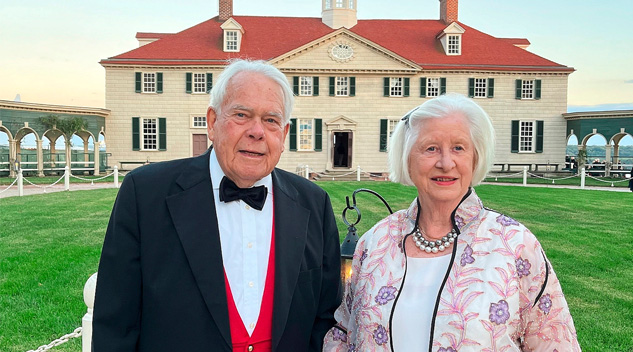#Jared #Clare #Edwards #Antiques #Arts #Weekly

Jared and Clare Edwards at George Washington’s Mount Vernon in September 2023.
Folks in the worlds of architectural history and historic preservation will probably be familiar with Jared Edwards, FAIA. In the spring of 2023, Edwards was awarded Preservation Connecticut’s Harlan H. Griswold Award for his contributions to the preservation and revitalization of Connecticut’s historic places, including the Old State House, Mark Twain House and Wadsworth Atheneum, and other landmarks. What readers may not know is that over time, he and his wife, Clare, formed a diverse and eclectic collection that will be sold at Brunk Auctions in early June. Antiques and The Arts Weekly was given the irresistible opportunity to speak to the collectors about what drove their collecting, and to get a glimpse of some of the sale’s upcoming highlights.
What inspired you to start collecting? What was the first piece you acquired, and why?
Jared and I were newly married, and we were living in a small house on a small budget. We drove up to Boston one Saturday and stopped in at the Vose Gallery. Our eyes immediately fastened on the Maxfield Parrish and we fell in love with it. Bob Vose must have sensed something in us and after some chit-chat he said, “Take it home with you and send along a little money every month.” Thereby was born a lifetime of collecting and a wonderful friendship with Bob Vose.
Brunk Auctions will be selling your collection on June 5. What are some of the things you consider most important from a historical perspective?
When Andrew Brunk came up to Hartford to meet us and see our things, it was apparently the “eclectic nature of our collection” that appealed to him.
In addition to the Maxfield Parrish you mentioned being your first acquisition, can you elaborate a bit more on some of the other highlights of the sale?
We have, for a long time, been admirers, collectors and scholars of the work of American impressionist, Dennis Miller Bunker (1861-1890). In 1979, Jared wrote an article titled “Denis Miller Bunker (1861-90) Rediscovered” that appeared in the Victorian Society of America’s magazine, Nineteenth Century. One of the works the article featured — “Vase with Yellow Rose” — has been in several traveling exhibitions and published in Painters of the Humble Truth: Masterpieces of American Still Life, 1801-1939 by Bill Gerdts (1981). “Vase with Yellow Rose” is one of nine works by Bunker in the auction at Brunk, which also includes his “Notre Dame de Larmor,” a rare undated watercolor that was a subject the artist painted as a student in France.
The first Bunker we purchased is one of his four sketches for a cover of a musical score by Charles Martin Loeffler, the first violinist of the Boston Symphony Orchestra. We own two of them and both are in the auction. With Bob Vose’s help over five years, we had collected a small body of surviving significant works by Dennis Miller Bunker, who died at the age of 29, including haunting and serenely beautiful landscape oil paintings, delicate still life pictures, penetrating portraits and superb graphite drawings on paper.

“Brook at Sunset” by Maxfield Parrish, 1931, signed and dated lower left “Maxfield Parrish 1931,” also signed and numbered by his son, panel verso “M.P.Jr. No. 59, painted by Maxfield Parrish, Maxfield Parrish Jr.,” oil on wood panel, 12 by 13½ inches; original artist designed painted and giltwood frame. Provenance: The Estate of the Artist; Vose Galleries, Boston, Mass. (label verso); The Collection of Clare and Jared Edwards, West Hartford, Conn.
Your collection may also contain some items that while perhaps not historically significant may be personal favorites for other reasons. Is that the case and, if so, what about those items appealed to you?
Some of the fun things we accumulated along the way of the hunt, the chase and the pounce have been kind of folky or just eye-catching. We honeymooned in Greece and on the island of Crete we came across a large collection of early Twentieth Century silver and tin votives which had been deaccessioned by one of the rural chapels. We bought the lot — images of arms and legs, children, eyes, etc. — and for 50 years put them on our Christmas trees. I went through a phase of collecting Northeast Native American beaded pillows made for the tourist trade. While traveling in Cuba we became delighted by papier mâché objects and wooden domino sets housed in wooden boxes representing buildings in Havana. In India we bought brass objects with decorative discs and bells which were used to decorate and protect the horns of the bullocks who pulled the carts in the smaller villages. Only the votives and a few of the pillows will be in the sale.
You’re selling the collection to downsize ahead. Why did you choose Brunk Auctions to handle this collection?
We sought the advice of three friends who were familiar with the range of our collection(s): a top-level employee of one of the premiere auction houses, a director of a major American museum and a serious private collector; the first choice of all three was Brunk.
There were likely some items that didn’t make the collection that is being sold at Brunk. Can you tell us about some of the things you held out?
I also collected antique dolls houses. In the end, I had 10 houses, seven fully furnished and populated. These will be going up for auction, with the help of Bertoia Auctions, sometime in the future.
—Madelia Hickman Ring




